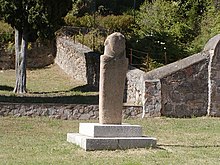Statuesmenhir Stantara d'Appriciani
The statue menhir Stantara d'Appriciani dates from the Bronze Age . It was found in Appriciani near Sagone in the Corse-du-Sud department on the Mediterranean island of Corsica in France . The top of the stone was placed on a base and is in the hamlet of Vico . In his notes from a trip to Corsica ( French Notes d'un voyage en Corse ) in 1840, the French writer Prosper Mérimée (1803–1870) describes the statue menhir as “Idolo dei Mori” ( German “Idol of the Moors” ).
description
The approximately 2.0 m high and only about 0.2 m thick granite statue was buried in the ground. The flat stone, shaped like a sheath, is rounded at the bottom and slightly narrowed. The top is shaped into a human head. The face is rough, but the eyes, nose, mouth, expressed by a single horizontal line, are well drawn. The hair that divides on the forehead forms two protruding curls at the level of the eyes. At this point the head has its greatest width (0.40 cm). Breasts or pectoral muscles are indicated, but the rest is perfectly smooth. At the back, the short-cut hair does not exceed the nape of the neck. The shoulder blades are about the size of the chest. It is a level 4 menhir.
Roger Grosjean presented a classification of the Corsican menhirs and statue menhirs in 1967, based primarily on the presence or absence of weapons.
- Level 1: Monoliths or baityloi less than a meter high ,
- Stage 2: Protoanthropomorph, the human form shown schematically,
- Level 3: Anthropomorphic figure with separate head and body; rarely more than two meters high, divided into:
- Level 4: "Southern statue menhirs, unarmed" have anatomical details, especially in the face (eyes, nose, mouth).
- Level 5: "Southern statue menhirs, armed" with swords, daggers and helmets or breastplates; anatomical details are not worked out (belt and loincloth).
- Level 6: "Northern statue menhirs, unarmed", thinner and slimmer than the previous statues; long neck and ears.
The stone was protected as a monument historique in 1840 .
See also
literature
- André D'Anna: Statues-menhirs, menhirs et mégalithisme de la Corse. 1995 - Projet collectif de recherches No ° 268
Individual evidence
Web links
- Figure antique d'Appriciani in the Base Mérimée of the French Ministry of Culture (French)
Coordinates: 42 ° 7 ′ 6.6 ″ N , 8 ° 41 ′ 24 ″ E

